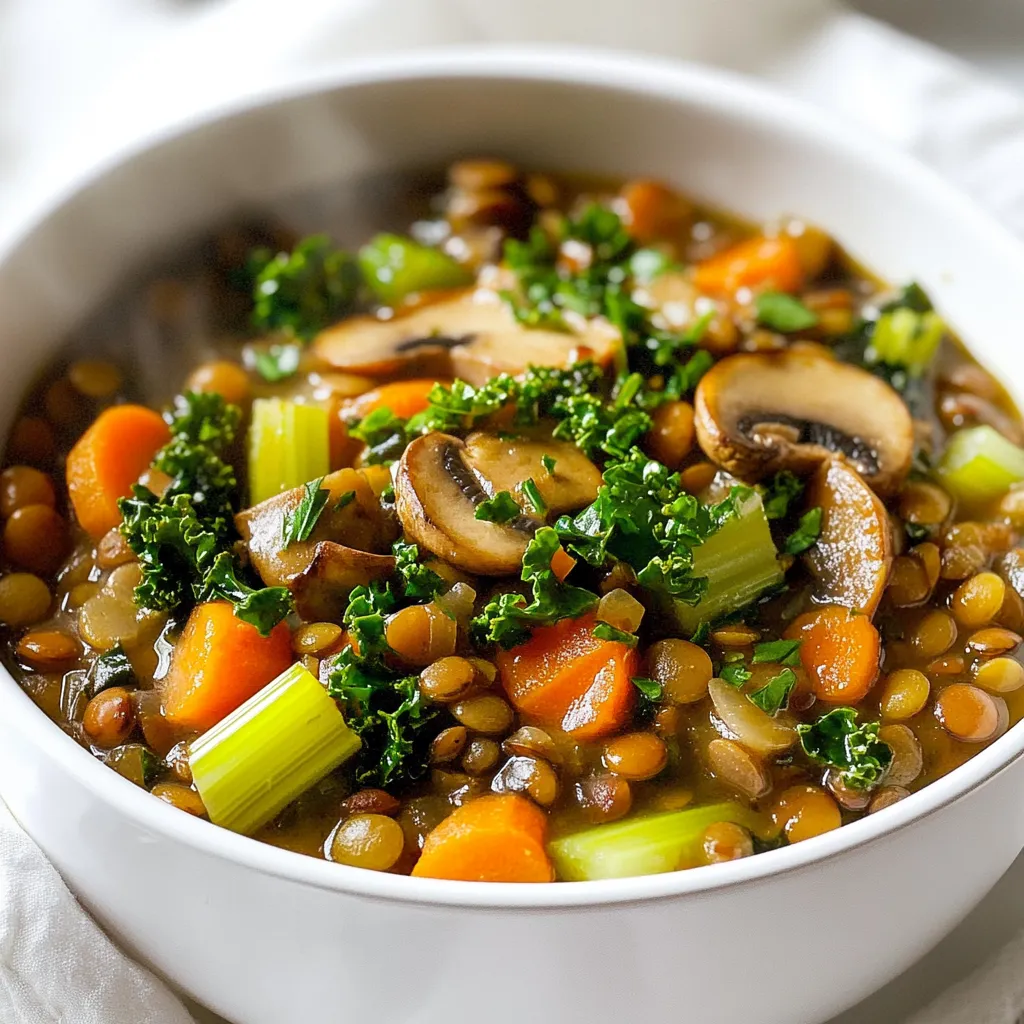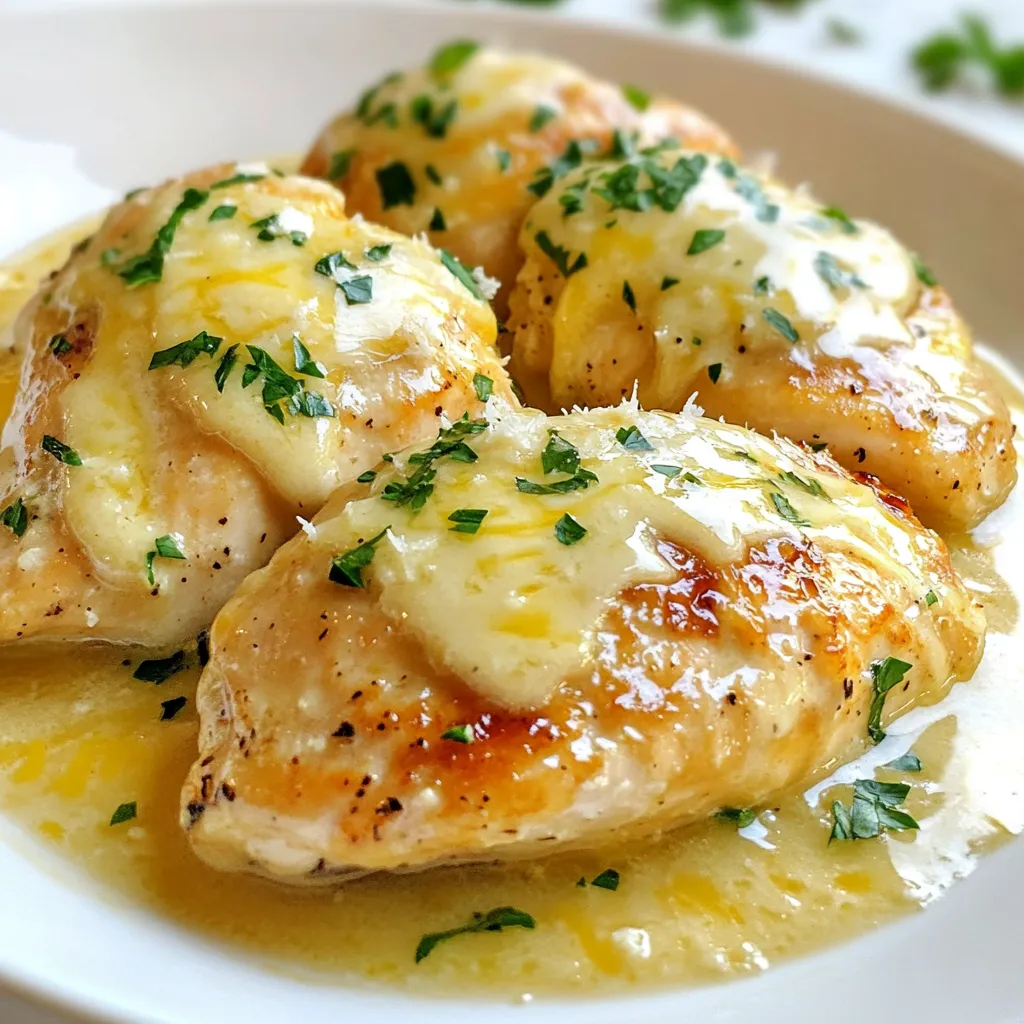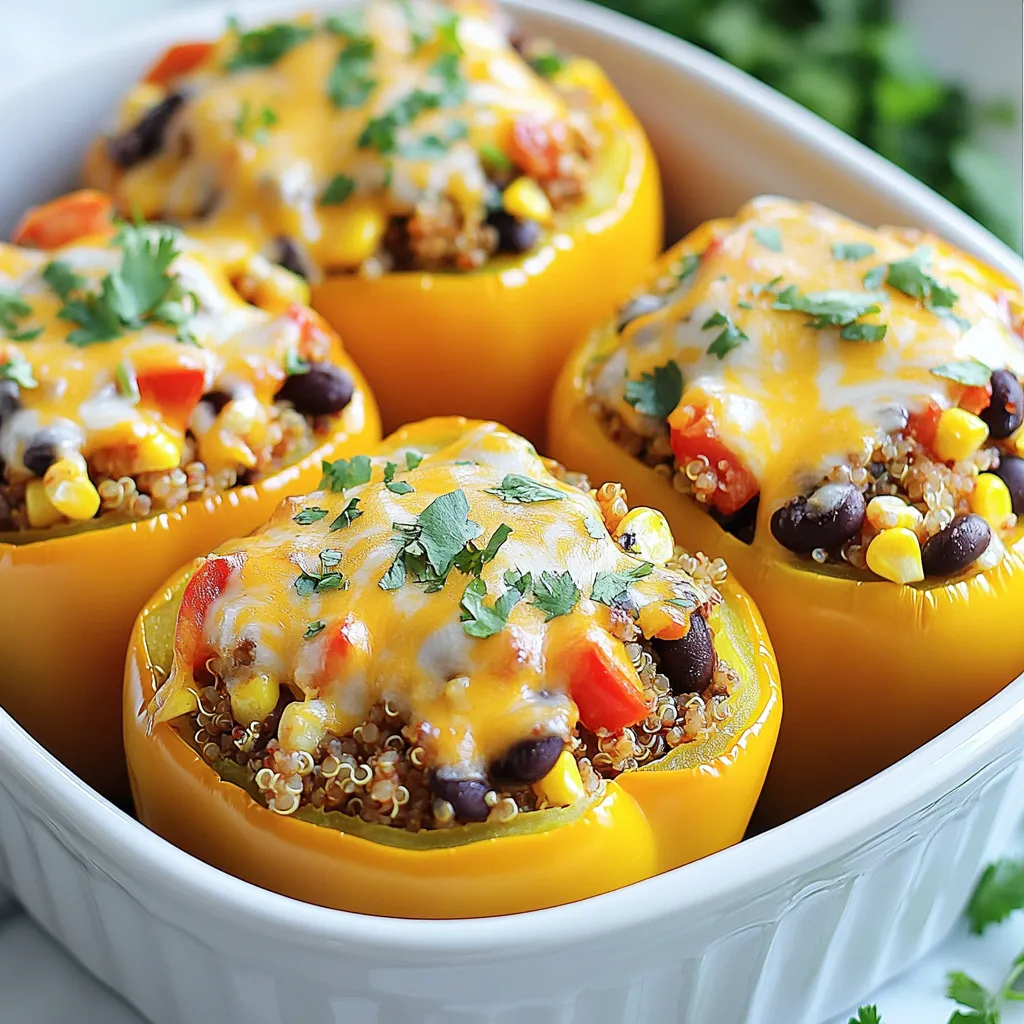Dinner

Vegan Lentil Mushroom Stew Hearty and Healthy Meal
Craving a delicious, hearty meal? My Vegan Lentil Mushroom Stew is the perfect choice! Packed with lentils, fresh veggies, and rich flavors, it’s not only

Slow Cooker Garlic Parmesan Chicken Delight Easy Meal
Are you ready to impress your family with a meal that’s both easy and tasty? Our Slow Cooker Garlic Parmesan Chicken is the answer. With

French Onion Chicken Thighs Flavorful and Simple Meal
Looking for a meal that’s both tasty and easy to make? Try my French Onion Chicken Thighs! This dish hits all the right notes with

Garlic Butter Shrimp Scampi Flavorful and Easy Recipe
If you love quick and tasty meals, then this Garlic Butter Shrimp Scampi recipe is for you! Packed with flavor and easy to make, this

Crockpot Cheesy Chicken Broccoli Rice Delight Recipe
Ready for a dinner that warms the heart? This Crockpot Cheesy Chicken Broccoli Rice Delight Recipe packs flavor and ease all in one dish! With

Biscuit Topped Chicken Pot Pie Comforting Family Meal
Picture this: a warm, flaky biscuit topping cradling tender chicken and veggies in a creamy sauce. That’s the magic of Biscuit Topped Chicken Pot Pie—a

Chicken Parmesan Zucchini Boats Flavorful and Easy Meal
Looking for a tasty and simple meal? Chicken Parmesan Zucchini Boats are your answer! They are fun to make and packed with flavor. You can

Cheesy Taco Stuffed Peppers Flavorful Family Meal
Are you ready for a fun family meal that’s both tasty and easy to make? These Cheesy Taco Stuffed Peppers bring great flavor and joy
![- 4 cups vegetable broth and 1 can (14 oz) diced tomatoes - 2 cups fresh spinach, roughly chopped - 1 cup sliced carrots, 1 cup diced zucchini, 1 onion, finely chopped, 3 cloves garlic, minced - 1 teaspoon Italian seasoning, 1/2 teaspoon red pepper flakes (optional) - 2 cups cheese tortellini (fresh or frozen) - 1 cup heavy cream - Fresh basil for garnish In my Crockpot Tortellini Soup, I start with vegetable broth and diced tomatoes. They bring a rich base to the soup. Next, I add fresh spinach, carrots, zucchini, onion, and garlic. These veggies add nutrition and flavor. For seasoning, I mix in Italian seasoning and red pepper flakes for a bit of heat. You can skip the red pepper if you prefer a milder soup. The cheese tortellini makes the dish hearty, while heavy cream adds a smooth finish. Finally, I garnish with fresh basil. It adds color and a burst of flavor that makes the soup special. Each ingredient plays a role in creating a warm and comforting meal. You can find the Full Recipe for more details on how to make this delicious soup. Start by chopping your vegetables. You will need: - 1 cup sliced carrots - 1 cup diced zucchini - 1 onion, finely chopped - 3 cloves garlic, minced - 2 cups fresh spinach, roughly chopped Next, measure your seasonings. You need: - 1 teaspoon Italian seasoning - 1/2 teaspoon red pepper flakes (optional) - Salt and pepper to taste Finally, prepare the tortellini. You can use 2 cups of cheese tortellini, either fresh or frozen. If using frozen, there's no need to thaw. Now it’s time to layer your ingredients in the crockpot. Start by adding the vegetable broth and the can of diced tomatoes, juice included. Then, add all the chopped veggies, garlic, and seasonings. Stir everything well. This step ensures even cooking. If you skip this, some ingredients may not cook right. Set your crockpot to low for 6 hours or high for 3 hours. Both options work well. You will know the soup is ready when the veggies are soft and the flavors meld together nicely. About 30 minutes before serving, add the tortellini. Let it cook until tender. This is key for a perfect bite. Before serving, stir in 1 cup of heavy cream and season with salt and pepper. Let the soup heat through for an extra 5-10 minutes. Enjoy your warm, hearty bowl of soup! For the full recipe, check out the detailed instructions at [Full Recipe]. To make your Crockpot Tortellini Soup great, you can adjust the cooking time. If you want a richer taste, cook it longer on low heat. This method allows all the flavors to blend well. Aim for about six hours on low or three hours on high. For the best flavor, add the heavy cream last. Stir it in right before serving. This keeps the cream smooth and tasty. Don’t rush this step. Letting the soup sit before adding tortellini also helps. This gives time for the veggies to shine. One common mistake is overcooking the tortellini. If you cook it too long, it becomes mushy. Add it in the last 30 minutes of cooking. This keeps the texture just right. Another mistake is forgetting to season. Always taste your soup before serving. Adjust with salt and pepper as needed. Fresh herbs like basil add a burst of flavor, so don’t skip them. They make the soup look nice, too! When serving your soup, think about sides. A warm piece of crusty bread pairs well. You can also serve a fresh salad for a bright touch. For garnishing, chop some fresh basil. Sprinkle it on top just before serving. You could also add a drizzle of olive oil for extra richness. A sprinkle of grated cheese can add a nice finish, too. For the full recipe, check the complete details above. Enjoy making this soup! {{image_2}} You can change up the veggies in your soup. Instead of spinach, try kale or Swiss chard. If you want more color, add bell peppers or peas. For a crunch, toss in some green beans or corn. You can also swap out the tortellini. Use mushroom or spinach tortellini for extra flavor. If you want a twist, try ravioli instead. They both add a nice touch to the dish. Want to make it vegan? Use vegetable broth and skip the cream. Swap cheese tortellini for a vegan version. You can find them in most stores now. If you need gluten-free options, look for gluten-free tortellini. Many stores sell them. You can also check for gluten-free pasta made from rice or lentils. It works well in this soup. Add more herbs to spice it up! Fresh thyme or rosemary can really boost the taste. You can also add a bay leaf while it cooks. Just remember to take it out before serving. For extra protein, add cooked chicken or sausage. Shredded rotisserie chicken is quick and easy. If you like sausage, pick a spicy one for some heat. Both make the soup heartier and more filling. For the full recipe, check out the complete instructions. After enjoying your Crockpot Tortellini Soup, let it cool down. Store it in an airtight container. This keeps it fresh. It will last in the fridge for about 3 to 4 days. If you want to enjoy it later, consider freezing. To freeze your soup, first let it cool completely. Then, pour it into freezer-safe bags or containers. Leave some space for expansion. Your soup will stay good for up to 3 months in the freezer. When you're ready to eat it, thaw it in the fridge overnight. Reheat on the stove until hot. You can also use the microwave for quick reheating. Meal prepping can save you time. You can chop your veggies and store them in the fridge. This makes cooking easy on busy days. I suggest portioning the soup into single servings. This way, you can grab and go. Use small containers for easy storage. Each portion should be about 1 to 1.5 cups. Crockpot Tortellini Soup takes about 6 hours on low or 3 hours on high. The longer cooking time helps all the flavors blend well. If you are pressed for time, the high setting works just fine. Yes, you can use frozen tortellini. Just add it in the last 30 minutes of cooking. Frozen tortellini cooks well and saves you prep time. If you use fresh tortellini, add it during the same time. Both options taste great! To make your soup heartier, add protein like cooked chicken or sausage. You can also add grains like quinoa or rice. These ingredients will fill you up and add more flavor to the dish. Enjoy experimenting with what you have on hand! This blog post covered making a tasty Crockpot Tortellini Soup. We explored essential ingredients like broth, tortellini, and fresh veggies. I shared step-by-step instructions for cooking and tips for perfecting your soup. Don't forget variations to customize your dish, and storage tips help you save leftovers. In the end, this recipe is simple and gives a comforting meal. Enjoy your cooking adventure!](https://grilledflavors.com/wp-content/uploads/2025/08/cbec9edf-113c-4191-917b-f273b177e316.webp)
Crockpot Tortellini Soup Hearty and Simple Recipe
Looking for a warm, filling soup that practically makes itself? My Crockpot Tortellini Soup is a simple, hearty dish perfect for busy days or cozy
![- 1 lb flank steak - 2 tablespoons olive oil - 2 tablespoons lime juice - 2 cloves garlic, minced - 1 teaspoon ground cumin - 1 teaspoon smoked paprika - 1 teaspoon chili powder - Salt and pepper to taste - 8 small corn tortillas The main star in this dish is the flank steak. This cut is tender and packed with flavor. You need to marinate it to enhance its taste. The marinade is simple. Mix olive oil, lime juice, minced garlic, cumin, smoked paprika, and chili powder in a bowl. Add salt and pepper to your liking. Corn tortillas are the best choice for this recipe. They are soft and hold the filling well. You can warm them on the grill for a few seconds before serving. - 1 cup fresh cilantro, chopped - 1 cup diced onions (white or red) - 1 avocado, sliced Fresh toppings make your tacos shine. Cilantro adds a nice herbal flavor. You can use either white or red onions for crunch and color. Avocado gives a creamy texture and balances the spices. - 1 cup pico de gallo or salsa for topping - Additional garnishes (hot sauce, lime wedges) Pico de gallo or salsa adds freshness and zest. You can also serve hot sauce for those who like heat. Lime wedges are perfect for squeezing over the tacos for extra flavor. For the full recipe, check here. Whisk together the marinade ingredients in a bowl. Use: - 2 tablespoons olive oil - 2 tablespoons lime juice - 2 cloves garlic, minced - 1 teaspoon ground cumin - 1 teaspoon smoked paprika - 1 teaspoon chili powder - Salt and pepper to taste Make sure to mix well. This creates a tasty blend. Next, take the flank steak and place it in a resealable bag. Pour the marinade over the steak, ensuring it is well-coated. Seal the bag tightly. Let it marinate in the fridge for at least 30 minutes. You can let it sit longer for more flavor. Preheat your grill to medium-high heat. This step is key for a good sear. Grilling the steak should take about 5-7 minutes on each side for medium-rare. Use a meat thermometer to check doneness; it should read about 130°F. After grilling, remove the steak and let it rest for 5 minutes. This helps the juices stay in. While the steak rests, warm your corn tortillas on the grill. Heat them for about 30 seconds on each side. This makes them soft and pliable. Once warmed, slice the steak against the grain into thin strips. To assemble, place a few slices of steak on each tortilla. Top with chopped cilantro, diced onions, avocado slices, and pico de gallo or salsa. This layering brings the best flavor to your tacos. Enjoy your meal right away for the best taste! For steak tacos, I recommend flank steak. It has a great flavor and cooks well. Other good options include skirt steak or sirloin. These cuts are tender and juicy when grilled. When it comes to seasoning, you can keep it simple or get creative. A basic mix of salt, pepper, and lime juice works wonders. I love adding garlic, cumin, and smoked paprika. This combination gives your steak a bold taste. To get those beautiful grill marks, preheat your grill. Aim for medium-high heat. This helps create a nice sear on the steak. Place the steak on the grill and avoid moving it around. Leave it alone for a few minutes. To prevent overcooking, use a meat thermometer. For medium-rare, look for 130°F. If you don’t have a thermometer, try the touch test. Press on the steak; it should feel firm but give a bit when you poke it. Tacos are all about toppings! Fresh cilantro and diced onions add crunch and flavor. I also recommend avocado slices for creaminess. If you want more heat, try adding jalapeños or a drizzle of hot sauce. Pair your tacos with a cold drink. A light beer or refreshing limeade complements the flavors well. You can also enjoy a classic margarita for a festive touch. For more details on making these delicious tacos, check the Full Recipe. {{image_2}} You can use skirt steak instead of flank steak. Skirt steak has great flavor and tenderness. It cooks quickly and is easy to slice. You can also try chicken or shrimp for a lighter option. Both will absorb the marinade well and taste delicious in tacos. Want some heat? You can spice up your marinade. Add more chili powder or some jalapeños. You can also try different salsas. Mango salsa adds a sweet twist. Pineapple salsa gives a fresh and tangy flavor, perfect for summer. If you need gluten-free tacos, use corn tortillas. They are safe and tasty. For low-carb options, think about lettuce wraps. Use large lettuce leaves to hold your fillings. This keeps it light and fresh, perfect for any diet. To keep leftover steak tasty, wrap it well. Use plastic wrap or foil. Place it in an airtight container. This helps keep the flavor and texture intact. Storing steak in the fridge works best for short-term use. If you want to save it longer, freeze it. Use freezer-safe bags or containers for this. When reheating steak, do it slowly. You can use the stovetop or oven. Heat it on low to avoid drying it out. Add a little broth or water to keep moisture. For tortillas, wrap them in a damp paper towel. Microwave them for about 15-20 seconds. This keeps them soft and fresh. For refrigerated leftovers, eat them within 3-4 days. If frozen, they last up to 3 months. Always check for signs of spoilage. Look for off smells or slimy textures. If you see these, it’s best to throw the steak away. Enjoy your grilled steak tacos while they are fresh! For the full recipe, check out the [Full Recipe]. The best steak for tacos is flank steak. It has great flavor and tenderness. Other good cuts include skirt steak and sirloin. These cuts work well when grilled. They absorb marinades nicely, which boosts their taste. Choose steaks that are well-marbled for juiciness. You should marinate the steak for at least 30 minutes. This gives the meat time to soak in flavors. For even more taste, marinate it for up to 2 hours. Avoid marinating for too long, as it may change the meat's texture. A shorter time will still add great flavor. Yes, you can prepare many taco ingredients in advance. Chop onions, cilantro, and avocado ahead of time. Store them in airtight containers. You can also marinate the steak the night before. This saves time on taco night. Just grill the steak and warm the tortillas when ready. Grilled steak tacos are a tasty and fun dish to make. We covered essential ingredients like flank steak, marinades, and fresh toppings. I shared step-by-step instructions for marinating, grilling, and assembling your tacos. You learned tips for choosing the best ingredients and methods to enhance your taco feast. Remember, variations exist, so feel free to try different meats and flavors. Proper storage is key to enjoying leftovers. Now, you have all the tools to make your next taco night a hit!](https://grilledflavors.com/wp-content/uploads/2025/08/4ad97ea6-b7f8-454d-8dac-6724a79784a8.webp)
Grilled Steak Tacos Savory and Simple Meal Guide
If you’re craving a delicious meal that’s both savory and simple, grilled steak tacos are your answer. In this guide, I’ll show you how to